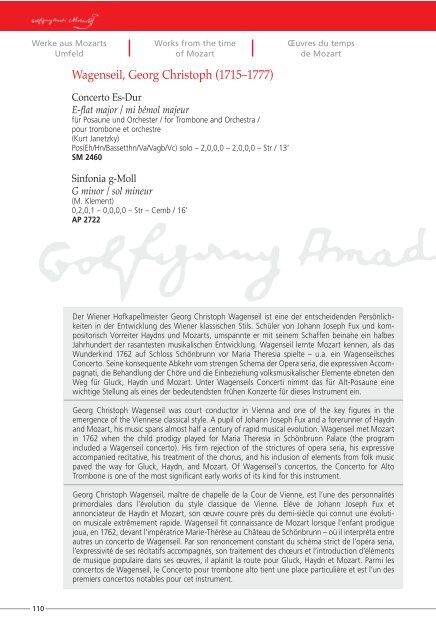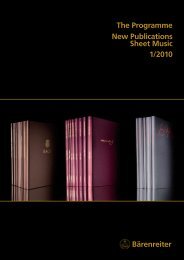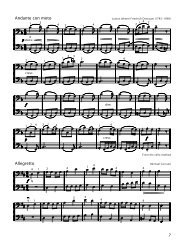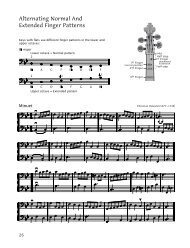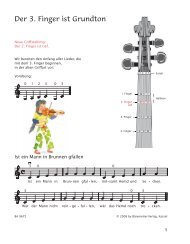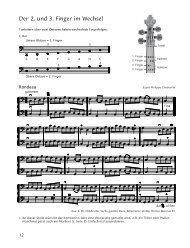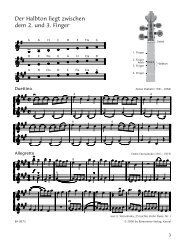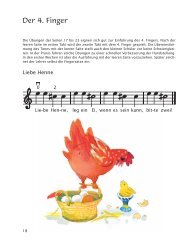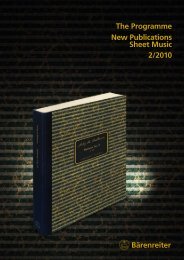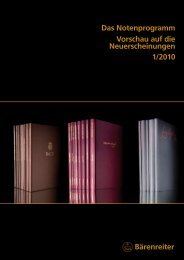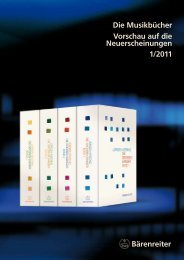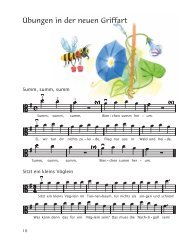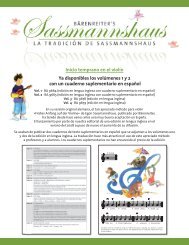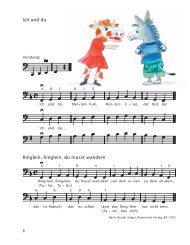Create successful ePaper yourself
Turn your PDF publications into a flip-book with our unique Google optimized e-Paper software.
<strong>Werke</strong> aus Mozarts<br />
Umfeld<br />
110<br />
Works from the time<br />
of Mozart<br />
Wagenseil, Georg Christoph (1715–1777)<br />
Concerto Es-Dur<br />
E-flat major / mi bémol majeur<br />
für Posaune und Orchester / for Trombone and Orchestra /<br />
pour trombone et orchestre<br />
(Kurt Janetzky)<br />
Pos(Eh/Hn/Bassetthn/Va/Vagb/Vc) solo – 2,0,0,0 – 2,0,0,0 – Str / 13’<br />
SM 2460<br />
Sinfonia g-Moll<br />
G minor / sol mineur<br />
(M. Klement)<br />
0,2,0,1 – 0,0,0,0 – Str – Cemb / 16’<br />
AP 2722<br />
Œuvres du temps<br />
de Mozart<br />
Der Wiener Hofkapellmeister Georg Christoph Wagenseil ist eine der entscheidenden Persönlichkeiten<br />
in der Entwicklung des Wiener klassischen Stils. Schüler von Johann Joseph Fux und kompositorisch<br />
Vorreiter Haydns und Mozarts, umspannte er mit seinem Schaffen beinahe ein halbes<br />
Jahrhundert der rasantesten musikalischen Entwicklung. Wagenseil lernte Mozart kennen, als das<br />
Wunderkind 1762 auf Schloss Schönbrunn vor Maria Theresia spielte – u.a. ein Wagenseilsches<br />
Concerto. Seine konsequente Abkehr vom strengen Schema der Opera seria, die expressiven Accompagnati,<br />
die Behandlung der Chöre und die Einbeziehung volksmusikalischer Elemente ebneten den<br />
Weg für Gluck, Haydn und Mozart. Unter Wagenseils Concerti nimmt das für Alt-Posaune eine<br />
wichtige Stellung als eines der bedeutendsten frühen Konzerte für dieses Instrument ein.<br />
Georg Christoph Wagenseil was court conductor in Vienna and one of the key figures in the<br />
emergence of the Viennese classical style. A pupil of Johann Joseph Fux and a forerunner of Haydn<br />
and Mozart, his music spans almost half a century of rapid musical evolution. Wagenseil met Mozart<br />
in 1762 when the child prodigy played for Maria Theresia in Schönbrunn Palace (the program<br />
included a Wagenseil concerto). His firm rejection of the strictures of opera seria, his expressive<br />
accompanied recitative, his treatment of the chorus, and his inclusion of elements from folk music<br />
paved the way for Gluck, Haydn, and Mozart. Of Wagenseil’s concertos, the Concerto for Alto<br />
Trombone is one of the most significant early works of its kind for this instrument.<br />
Georg Christoph Wagenseil, maître de chapelle de la Cour de Vienne, est l’une des personnalités<br />
primordiales dans l’évolution du style classique de Vienne. Elève de Johann Joseph Fux et<br />
annonciateur de Haydn et Mozart, son œuvre couvre près du demi-siècle qui connut une évolution<br />
musicale extrêmement rapide. Wagenseil fit connaissance de Mozart lorsque l’enfant prodigue<br />
joua, en 1762, devant l’impératrice Marie-Thérèse au Château de Schönbrunn – où il interpréta entre<br />
autres un concerto de Wagenseil. Par son renoncement constant du schéma strict de l’opéra seria,<br />
l’expressivité de ses récitatifs accompagnés, son traitement des chœurs et l’introduction d’éléments<br />
de musique populaire dans ses œuvres, il aplanit la route pour Gluck, Haydn et Mozart. Parmi les<br />
concertos de Wagenseil, le Concerto pour trombone alto tient une place particulière et est l’un des<br />
premiers concertos notables pour cet instrument.


